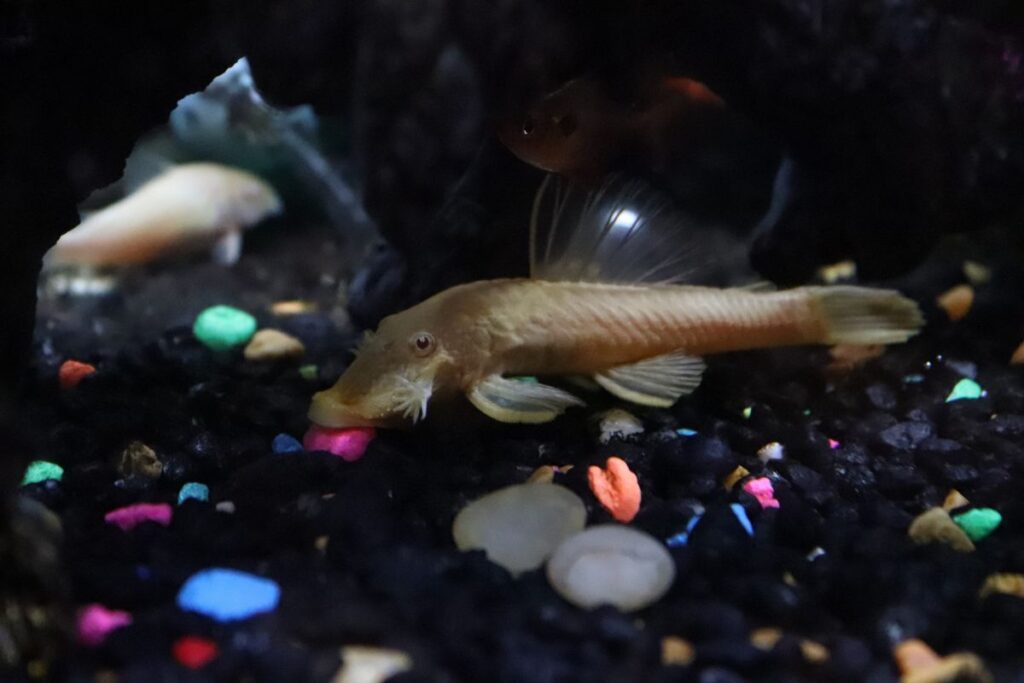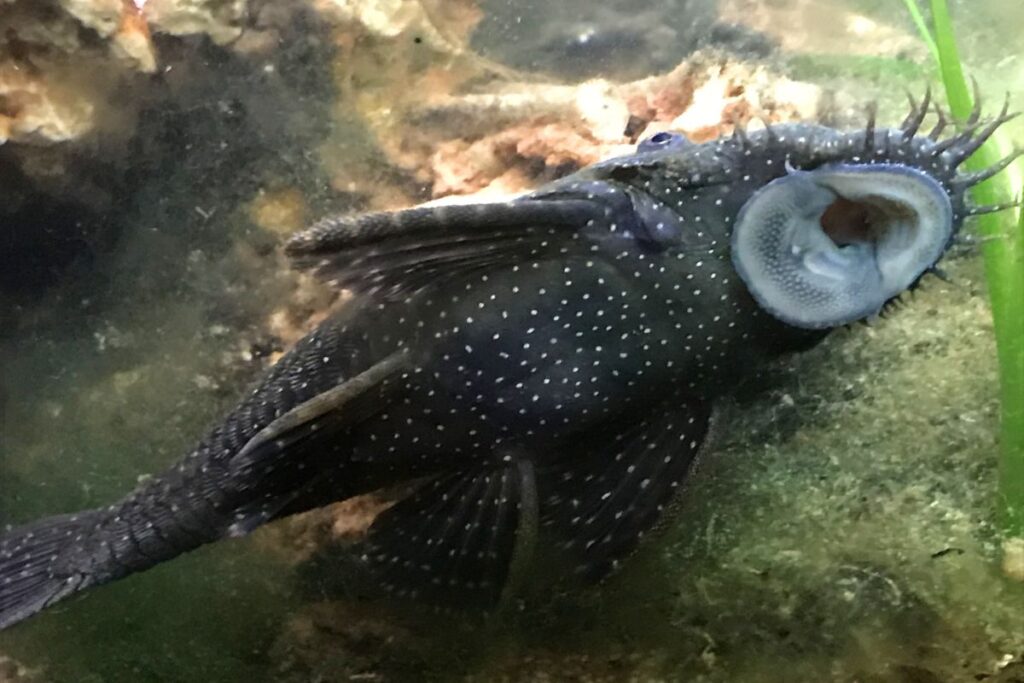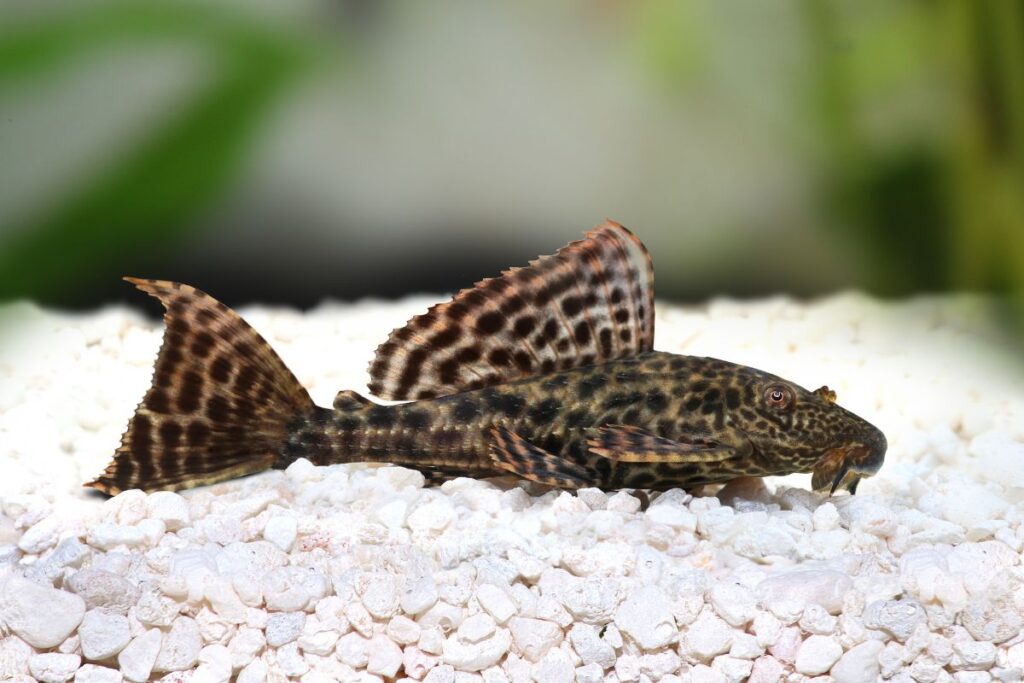If you’re a fish enthusiast, you’re probably familiar with the pleco. This popular freshwater fish is known for its unique appearance and ability to clean aquariums. But have you ever wondered if plecos are nocturnal?
Yes, plecos are mostly nocturnal fish, meaning they are active during the night and rest during the day.
As an avid fish keeper myself, I’ve often found myself wondering about the behavior of my pets. After all, understanding their habits and preferences can help us create a more comfortable environment for them.
In this article, we’ll explore the question of whether or not plecos are nocturnal, and what that means for their care.
So, if you’re curious about pleco behavior, or just want to learn more about these fascinating fish, keep reading!

Table of Contents
What are Plecos?
Plecos, also known as plecostomus or suckerfish, are a type of freshwater fish that belong to the Loricariidae family.
They are native to South America and are popular among aquarium enthusiasts for their unique appearance and ability to clean algae from tank walls. Plecos come in a variety of sizes, ranging from a few inches to over two feet long.
They have a flat, armored body and a large mouth that they use to scrape algae off surfaces. Some species have a distinctive pattern of spots or stripes, while others are solid in color.
As bottom-dwelling fish, plecos are often nocturnal and prefer to hide during the day. They are also known for their ability to breathe air, which allows them to survive in low-oxygen environments.
I remember the first time I saw a pleco in an aquarium. It was a small one, only a few inches long, but it was fascinating to watch as it moved along the glass, cleaning up algae as it went.
I was immediately drawn to their unique appearance and quirky behavior. Overall, plecos are a fascinating addition to any aquarium. They not only add visual interest, but also serve an important role in keeping the tank clean and healthy.
Nocturnal Behavior
When we talk about nocturnal animals, we refer to those that are active during the night and rest during the day. Nocturnal animals have evolved to adapt to the darkness and have developed several physical and behavioral traits that allow them to thrive in low-light environments.
Evidence of Nocturnal Behavior in Plecos
As an aquarium enthusiast, I have observed the behavior of several fish species, including plecos. Plecos are known for their nocturnal behavior, which is evident in their activity patterns.
During the day, plecos are usually inactive, hiding in their caves or under rocks. However, as the night falls, plecos become more active, swimming around the tank, scavenging for food, and exploring their surroundings.
Moreover, plecos have several physical adaptations that allow them to thrive in the dark. They have large eyes that are sensitive to low light, allowing them to see in the dark.
Plecos also have a keen sense of smell, which helps them locate food in the dark. Additionally, they have a unique ability to cling onto surfaces, which enables them to navigate their environment with ease.
In conclusion, plecos are nocturnal animals that have evolved to adapt to the darkness. Their physical and behavioral traits allow them to thrive in low-light environments, making them fascinating creatures to observe in an aquarium setting.
Reasons for Nocturnal Behavior
Natural Habitat
The natural habitat of plecos is often in murky or muddy water in South American rivers and streams.
These conditions make it difficult for them to see during the day, so they have adapted to being active at night when they can navigate more easily. In their native environment, plecos are most active during the hours of darkness, and they rest during the day.
Predator Avoidance
Plecos are preyed upon by a variety of animals, including larger fish, birds, and mammals. By being nocturnal, they can avoid these predators and increase their chances of survival.
During the day, they often hide in crevices or under rocks to avoid detection. This behavior is a survival mechanism that has helped plecos survive in their natural habitat.
Feeding Behavior

Plecos are known for their scavenging behavior and their ability to clean algae from aquariums. They are most active at night when they feed on algae and other plant matter that grows in their environment.
By being nocturnal, they can take advantage of the abundance of food that is available during the night, and they can avoid competition from other fish that may also be feeding during the day.
Personally, I have noticed that my pleco is most active at night. When I turn off the aquarium lights, he comes out of his hiding spot and begins to swim around the tank.
He seems to be more energetic and playful at night, and he often interacts with the other fish in the tank. It’s fascinating to watch his behavior and see how he has adapted to his environment.
Other Behavioral Characteristics
Social Behavior
Plecos are generally solitary fish, but they can be kept with other fish as long as they have enough space to establish their own territories.
They are not aggressive towards other fish, but they may become territorial if they feel threatened or crowded. Plecos are known to establish a hierarchy within their own species, with larger and more dominant individuals asserting their dominance over smaller and weaker ones.
I remember when I first introduced a pleco into my aquarium, it was interesting to see how it interacted with my other fish.
At first, it kept to itself, but over time it became more comfortable and started to explore the tank. It even became friends with one of my angelfish, and they would often swim together.
Territorial Behavior
Plecos are territorial fish and will defend their chosen spot in the aquarium. They will often establish territories in caves, under rocks, or in other hiding spots.
If another fish enters their territory, they may become aggressive and chase the intruder away. It is important to provide enough hiding spots and caves for plecos in the aquarium to prevent territorial disputes.
One thing I noticed about my pleco is that it was very particular about its hiding spot. It had found a spot under a piece of driftwood and would defend it fiercely if any other fish tried to enter.
I had to rearrange the aquarium a few times to make sure every fish had its own space, but eventually, they all found their own territories and lived peacefully together.
Do Plecos Come Out in the Day?

Many people wonder if plecos are strictly nocturnal creatures or if they come out during the day as well. The truth is that plecos are primarily nocturnal, but they can also be active during the day.
During the day, plecos will often find a hiding spot to rest and conserve their energy. They may also come out to eat or explore their environment if they feel safe and comfortable. However, plecos are more active and visible at night when they are searching for food and mates.
Personally, I have observed my pleco coming out during the day on several occasions. I have a hiding spot in my aquarium where my pleco likes to rest, but I have also seen it swimming around and exploring during the day. However, it is much more active at night and will often come out to scavenge for food.
It is important to note that the behavior of plecos can vary depending on the individual fish and their environment.
Some plecos may be more active during the day, while others may be strictly nocturnal. It is also possible for plecos to adjust their behavior over time as they become more comfortable in their surroundings.
In summary, plecos are primarily nocturnal creatures, but they can also be active during the day.
While they may rest and conserve their energy during the day, they may also come out to explore or eat if they feel safe and comfortable. However, they are much more active and visible at night when they are searching for food and mates.
Recommended Amazon products for this article:
- NICREW ClassicLED Aquarium Light – This aquarium light is perfect for Pleco owners who want to observe their fish during the nighttime hours. The LED lights simulate natural moonlight and can help to encourage Plecos to be more active during the night.
- Hikari Tropical Sinking Wafers – These sinking wafers are a great food option for Plecos, especially during the nighttime when they are most active. The wafers are made with high-quality ingredients and provide essential nutrients for your fish.
- Hygger Quiet Mini Air Pump – This mini air pump is perfect for Pleco owners who want to provide their fish with extra oxygen during the nighttime hours. The pump is very quiet and won’t disturb your fish or disrupt their nocturnal behavior.
Overall, these products can help Pleco owners better understand and care for their fish during the nighttime hours when they are most active. The aquarium light can help to simulate natural moonlight, the sinking wafers provide essential nutrients, and the mini air pump can help to provide extra oxygen for your fish.
Conclusion
After conducting research and observing the behavior of plecos, it is clear that they are primarily nocturnal. While they may come out during the day to feed or explore, they are most active at night.
This is likely due to their natural habitat in the wild, where they would hide during the day to avoid predators and come out at night to feed.
It’s important to keep this in mind when caring for plecos in an aquarium. Providing hiding places and dim lighting during the day can help them feel more comfortable and mimic their natural environment.
Additionally, feeding them at night when they are most active can ensure they are getting the proper nutrients they need.
While some may argue that plecos can be active during the day, it’s important to remember that each fish is unique and may have different behaviors. However, the majority of research and observations suggest that plecos are indeed nocturnal.
Personally, I have observed my own pleco primarily coming out at night to feed and explore. While he may occasionally come out during the day, he seems most comfortable and active at night. This aligns with the research and reinforces the idea that plecos are nocturnal creatures.
In conclusion, while there may be some debate on whether plecos are truly nocturnal, the evidence suggests that they are primarily active at night. By understanding and accommodating their natural behavior, we can provide the best care for these fascinating fish.
“Learn how to keep your pleco healthy and happy with our Pleco Care 101 guide – the ultimate resource for all pleco owners!”
FAQs
Should I feed my pleco at night?

It is not necessary to feed your pleco at night. Plecos are known to be nocturnal, but they can feed during the day as well. You can feed your pleco once or twice a day, depending on the size and age of the fish. It is important to note that plecos are herbivores, so their diet should consist of vegetables, algae wafers, and pellets.
Do plecos need light at night?
Plecos do not need light at night. In fact, too much light can disrupt their natural sleep cycle. It is recommended to provide your pleco with a consistent light schedule, with 10-12 hours of light and 12-14 hours of darkness. This will help them maintain a healthy sleep cycle and reduce stress.
Are plecos active fish?
Yes, plecos are active fish. While they are known to be nocturnal, they can be active during the day as well. It is important to provide your pleco with enough space to swim and explore, as well as hiding spots to rest and feel safe. Keeping your aquarium clean and well-maintained can also help keep your pleco active and healthy.
Personally, I have a pleco in my own aquarium and I have found that it is most active during the night. I usually feed it once a day, in the morning, and it seems to be doing well. I have also provided it with a few hiding spots, such as caves and plants, and it seems to enjoy exploring and resting in those areas.
Reference: Pleco Wikipedia.
